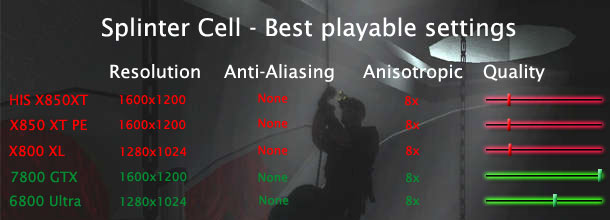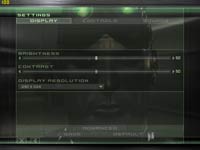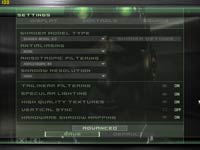Splinter Cell: Chaos Theory
Publisher: UbisoftWe are using the full version of Splinter Cell: Chaos Theory patched to version 1.02. It features a new game engine that has been created around a heavily modified Unreal Engine 2 - the important thing to note is that the game only has two Shader profiles: Shader Model 1.1 and Shader Model 3.0. This means that all of ATI's video cards default to Shader Model 1.1, and only the GeForce 6 series are capable of using the Shader Model 3.0 path.
Despite the fact that ATI's cards only use a DirectX 8.1, Shader Model 1.1 path, the quality of rendering is fantastic in comparison to the Shader Model 3.0 rendering. However, the Shader Model 3.0 profile means that the GeForce 6 series and higher video cards are given a number of options for additional eye candy, including Parallax Mapping, High Dynamic Range Rendering, Tone Mapping and High-Quality Soft Shadows. These can all be enabled on GeForce 6 and GeForce 7 series video cards, and will make the gaming experience more realistic providing there is enough graphics processing power available.
We configured both Anti-Aliasing and Anisotropic Filtering from within the game, and thus the driver control panel was left set to "Application Controlled".
Below is a table of the best-playable settings that we found best for each video card configuration. In this title, we found that 25 to 30 frames per second minimum and a target of 50 frames per second (or higher) for the average frame rate delivered a smooth and fluid gaming experience across the rest of the game.

Despite the higher resolution that the HighTech Radeon X850 XT iTurbo is using, the image quality is not close to what can be achieved on GeForce 7800 GTX. This card is in a league of its own thanks to the maximum in-game detail settings that we were able to turn on and still experience smooth game play at 1280x1024 with 8xAF. This included High-Dynamic Range Rendering, Parallax Mapping, Tone Mapping and High Quality Soft Shadows.
We did not find that we could add any image quality when using HighTech's enhanced iTurbo clock speeds, and the frame rate increase was not all that massive. We are talking two or three frames per second on average, while the minimum frame rate increased by a single frame per second. It was slightly smoother, but not hugely noticeable in all honesty.

MSI MPG Velox 100R Chassis Review
October 14 2021 | 15:04








Want to comment? Please log in.